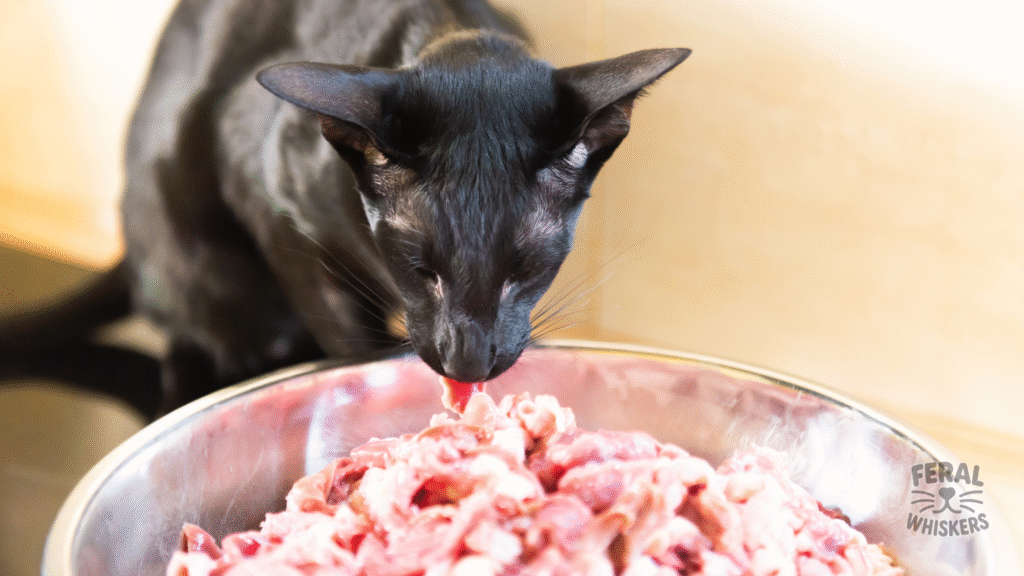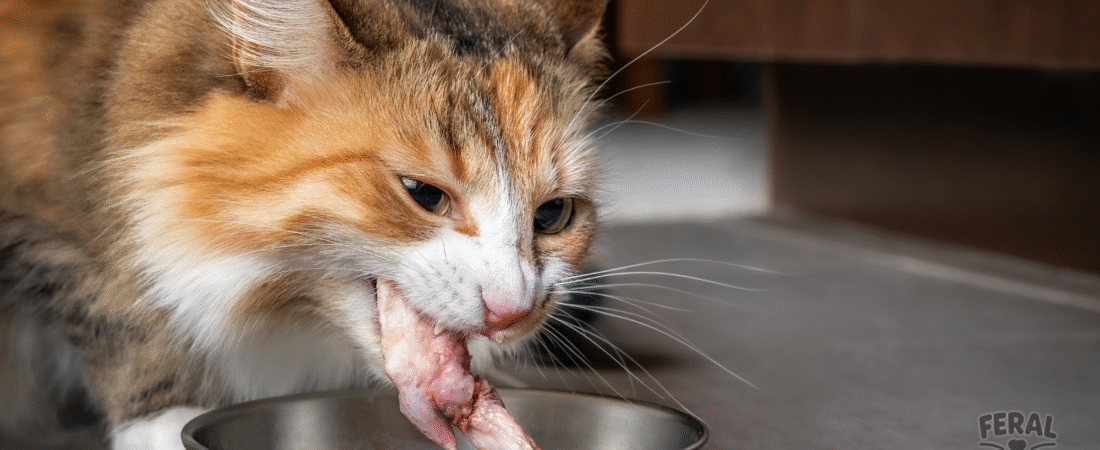📌 What is a Raw Food Diet for Cats?

A raw food diet for cats is designed to replicate what felines would eat in the wild. Cats are obligate carnivores, meaning their bodies require animal protein and fat to survive. Unlike omnivores (dogs, humans), cats cannot thrive on carbohydrates.
Types of Raw Diets include:
- Homemade raw: Owners prepare meals from raw meat, organs, bones, and supplements.
- Commercial frozen raw: Pre-made, balanced raw diets found in pet stores (kept frozen, thawed before serving).
- Freeze‑dried/dehydrated raw: Lighter, shelf‑stable; just add water before feeding.
- Hybrid diets: Raw as one meal and canned/kibble in others.
Typical raw meal breakdown (Prey Model Raw / PMR):
- 80% muscle meat
- 10% organs (liver, kidney, spleen, etc.)
- 10% bone (finely ground for safety)
This mimics a “whole prey” animal, such as a mouse.
🐱 Benefits of a Raw Diet for Cats
Raw feeding advocates highlight many potential improvements:
- Closer to Nature: Cats are hunters by design and thrive on raw prey. Raw diets mimic this.
- Improved Digestion: Cats fed raw often produce smaller, less smelly stools, indicating better digestion.
- Healthier Skin & Shiny Coat: The natural fats nourish skin, reduce dandruff, and make coats glossy.
- Hydration Support: Raw meat is ~70–75% water, helping cats stay hydrated and supporting kidney/urinary health.
- Lean Muscle, Less Fat: High-protein, low-carb diets promote healthier body composition.
- Dental Health: Cats chewing on raw meaty bones (like chicken necks) may reduce plaque buildup.
- Reduced Allergies/Sensitivities: Some cats with food allergies or intolerances respond better to single‑protein raw diets.
💡 Example: Many owners report their cats shed less fur, have more energy, and even show calmer behavior after switching to raw.
⚠️ Risks and Challenges
Raw diets are not automatically safe. Potential downsides include:
- Pathogens: Raw meat can contain bacteria like Salmonella or E. coli. Cats often tolerate them, but humans in the household are at risk.
- Nutrient Imbalances: Feeding “just raw chicken” is dangerous — it lacks taurine, calcium, and vitamins. Balanced recipes or commercial raw formulas are essential.
- Bone Hazards: Whole, cooked bones are dangerous (splintering). Even raw bones can risk intestinal blockage if too large. Ground bone is safer.
- Immune System Risks: Cats with chronic illness or suppressed immunity (or elderly cats) may not tolerate raw well.
- Cost and Storage: Buying quality meat and freezer space can increase costs. Commercial raw diets are more expensive per meal than kibble or canned.
💡 Important: Many health issues from raw feeding arise from poorly balanced DIY meals. Cats can’t “make up” for missing nutrients like taurine — they need everything daily.
🥦 Vegetables and Cats
Cats do not require vegetables, but a small amount of fiber can be beneficial.
Allowed in raw diets (optional, always finely pureed):
- Pumpkin → Supports digestion, relieves constipation or diarrhea.
- Carrot → Adds fiber, gently scrapes intestines.
- Zucchini → Hydrating and light for digestion.
- Parsley → Natural breath freshener, mild diuretic.
Vegetables to avoid: Onion, garlic, leeks, avocado, grapes, raisins — all toxic to cats.
💡 Rule of thumb: Veggies should never be more than 5% of a raw diet.
🔍 Expert/Vet Perspective
Veterinary opinions on raw diets are divided:
- Supportive holistic vets: Believe raw improves digestion, reduces chronic illnesses, and mimics evolution.
- Conventional vets: Worry about bacterial contamination, nutritional imbalances, and human health risks.
The consensus:
- A raw diet can work, but only if properly balanced and safely handled.
- Commercial complete raw diets are generally safer than DIY meals, unless you’ve had recipes reviewed by a veterinary nutritionist.
🌿 Holistic & Kitchen Supports for Raw Diets
Raw feeding can be enhanced with natural additions:
- Pumpkin purée: 1 tsp → Helps stool consistency.
- Goat kefir/probiotics: Tiny drops → Restore gut flora.
- Bone broth (unsalted): Provides hydration and minerals.
- Fish oil (vet‑-approved): Rich in omega‑3 fatty acids for coat and heart.
- Egg yolk (raw or lightly cooked): Adds extra vitamins and supports a healthy coat.
⚠️ Avoid giving garlic, onions, strong herbs, or essential oils — toxic to cats.
🛒 How to Transition Safely
Switching from kibble or canned to raw should be gradual:
- Start Slowly: Begin with 10% raw mixed into their usual food.
- Increase Over Days/Weeks: Gradually increase raw, decrease old food.
- Start with one protein (like chicken or turkey): Then expand to other meats (rabbit, duck, beef, fish).
- Monitor stool and appetite: Loose stool, vomiting, or refusal may mean changing pace or protein.
- Ensure balance: Use balanced commercial raw or a formulated recipe (with supplements like taurine, calcium, and vitamin E).
💡 Tip: Kittens adapt to raw diets faster than adults because they’re still exploratory eaters.
🏡 Safety & Handling Guidelines
Since raw food can contaminate surfaces:
- Always freeze meat minimum 72 hrs before feeding (kills parasites).
- Thaw in fridge — not on counters.
- Use stainless steel bowls, easy to sanitize.
- Wash hands, utensils, and surfaces after handling.
- Discard uneaten raw food after 1–2 hours.
❓ FAQs
Q1: Is raw food safe for kittens?
Yes, but it must be nutritionally complete and balanced — kittens have higher caloric and nutrient needs.
Q2: Can freeze‑dried raw be fed as “raw”?
Yes. It’s safer (less bacteria) and portable. Just rehydrate with water before feeding.
Q3: Is homemade raw cheaper than commercial?
Homemade can be cheaper if buying meat in bulk, but balancing with supplements is mandatory. Commercial raw is convenient but higher priced.
Q4: Does raw food cure health problems?
It won’t “cure,” but raw diets often reduce allergies, obesity, and digestive issues, leading to better overall wellness.
💡 Final Thoughts
A raw food diet can give cats vibrant health closer to their natural biology. Owners often report shinier coats, better digestion, and more energy. But it also comes with responsibility: safe handling, ensuring nutritional balance, and consistent veterinary oversight.
✅ Key takeaway: Raw feeding is not simply “raw meat.” It’s a carefully designed, balanced, and managed diet — when done correctly, it can be one of the healthiest ways to nourish your cat.

